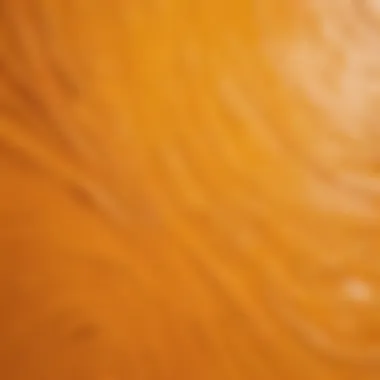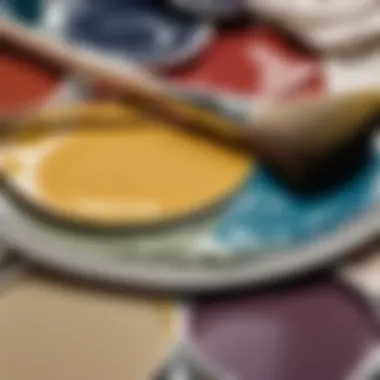Materials:
- Acrylic latex house paint (ensure it is suitable for indoor or outdoor use)
- Paintbrushes of various sizes (small for detail work, medium for broad strokes)
- Painter's tape to protect surfaces not meant to be painted
- Drop cloths to cover floors and furniture for easy cleanup
- Paint trays for pouring and mixing paint
- Stir sticks to ensure the paint is well-mixed
DIY Steps:
- Start by preparing the area to be painted. Remove any furniture or items from the space and cover floors with drop cloths.
- Clean the surfaces to be painted thoroughly to ensure proper adhesion of the paint.
- Use painter's tape to mask off any areas you do not want to paint, such as trim or windows.
- Pour the acrylic latex house paint into the paint tray and use the appropriate brush size for the area you are painting.
- Apply the paint in smooth, even strokes, working from top to bottom to avoid drips and streaks.
- Allow the first coat to dry completely before applying a second coat for even coverage.
- Once the final coat is dry, remove the painter's tape carefully to reveal clean, sharp lines.
Technical Aspects:
- Use high-quality paintbrushes to ensure smooth application and professional results.
- Allow each coat of paint to dry fully according to the manufacturer's recommendations before applying the next coat.
- Take note of the temperature and humidity levels in the room, as they can affect the drying time and finish of the paint.
- Experiment with different application techniques such as swirling, stippling, or cross-hatching for unique textures.
DIY Project Process:


- Start by gathering all materials and tools needed for the project.
- Follow the detailed instructions provided earlier to prep the space, apply the paint, and achieve a professional finish.
- If you encounter any issues such as drips, brush marks, or uneven coverage, refer to the troubleshooting tips mentioned below.
Troubleshooting Tips:


- For drips or runs, gently sand the area once it's dry and apply a thin layer of paint to blend it in.
- To fix brush marks, lightly sand the surface between coats and use wide, sweeping brush strokes.
- In case of uneven coverage, apply an additional coat of paint using a cross-hatch technique to ensure even distribution.
- If the paint is not adhering properly, ensure the surface is clean and dry before reapplying paint.
Introduction


Acrylic latex house paint is a versatile and indispensable tool in the realm of home improvement and decoration. Understanding the nuances of this dynamic paint type is crucial for achieving optimal results in various projects. This article aims to delve deep into the world of acrylic latex house paint, shedding light on its properties, benefits, application techniques, and environmental implications. By exploring each facet comprehensively, readers will gain an in-depth understanding of how acrylic latex paint can elevate their home spaces.
Understanding Acrylic Latex House Paint
Composition of Acrylic Latex Paint
The composition of acrylic latex paint plays a pivotal role in its efficacy and durability. Comprising acrylic polymers and latex, this type of paint offers a water-based solution that is quick-drying and long-lasting. The key characteristic of acrylic latex paint lies in its ability to provide a smooth finish while being resistant to fading and yellowing, ensuring a pristine appearance over time. The unique feature of acrylic latex paint is its versatility in adhering to various surfaces, including wood, metal, and concrete. This adaptability makes it a popular choice for both interior and exterior applications, catering to a wide range of painting needs.
Key Characteristics
One of the key characteristics of acrylic latex paint is its excellent adhesion properties, allowing for seamless application and long-term adherence to surfaces. Additionally, its low odor and easy cleanup make it a preferable option for indoor projects, ensuring a pleasant painting experience. The unique feature of acrylic latex paint's flexibility enables it to expand and contract with different weather conditions, minimizing the risk of cracking or peeling. These advantages make acrylic latex paint a reliable choice for homeowners looking for a durable and versatile painting solution.
Check for more detailed insights on the benefits, application techniques, and environmental considerations in the upcoming sections of this article.
Benefits of Acrylic Latex House Paint
When it comes to selecting the right paint for your home, the benefits of acrylic latex house paint cannot be overstated. This section will delve into the various advantages that make acrylic latex paint a top choice for housewives and homeowners seeking quality and durability in their painting projects.
Durability and Longevity
Resistance to Cracking and Peeling
Acrylic latex house paint boasts exceptional resistance to cracking and peeling, making it a reliable choice for creating a pristine and long-lasting finish on interior and exterior surfaces. The key characteristic of this paint is its ability to withstand extreme weather conditions and fluctuating temperatures without compromising its structural integrity. This feature ensures that your painted surfaces maintain their pristine look for years to come, reducing the need for frequent touch-ups and maintenance. The unique feature of resistance to cracking and peeling significantly contributes to the overall longevity and durability of acrylic latex house paint, making it a popular and beneficial choice for both residential and commercial applications.
UV Protection
Another significant aspect of acrylic latex house paint is its excellent UV protection properties. The key characteristic of UV protection in this paint helps prevent color fading and degradation caused by prolonged exposure to the sun's harmful rays. By incorporating UV-resistant additives, acrylic latex paint ensures that your painted surfaces retain their vibrant colors and aesthetic appeal for an extended period. This unique feature offers the advantage of maintaining the visual integrity of your paint job, making it a practical choice for outdoor applications where exposure to sunlight is inevitable.
Ease of Cleaning and Maintenance
Stain Resistance
One of the standout features of acrylic latex house paint is its impressive stain resistance capability. This specific aspect makes the paint ideal for areas prone to spills, splashes, and stains, such as kitchens, bathrooms, and high-traffic living spaces. The key characteristic of stain resistance allows for easy cleaning and maintenance, as most stains can be wiped away effortlessly without leaving lasting marks or discoloration. By choosing acrylic latex paint with superior stain resistance, homeowners can enjoy peace of mind knowing that their painted surfaces will remain pristine and blemish-free even in the face of everyday mishaps.
Scrubbing Ability
Complementing its stain resistance, acrylic latex house paint also offers exceptional scrubbing ability, enabling homeowners to remove stubborn marks and dirt with ease. The key characteristic of scrubbing ability lies in the paint's formulation, which allows for gentle scrubbing with soap and water without damaging the finish or color integrity. This unique feature ensures that painted surfaces can be maintained regularly, enhancing their longevity and preserving their original beauty. Whether tackling tough stains or general dirt buildup, acrylic latex paint's scrubbing ability simplifies cleaning tasks and promotes a lasting, fresh appearance throughout your home.
Versatile Application
Suitability for Various Surfaces
Acrylic latex house paint is renowned for its versatility in adhering to a wide range of surfaces, including drywall, wood, metal, and masonry. This specific aspect of suitability for various surfaces makes the paint a versatile choice for different projects, whether interior renovations or outdoor enhancements. The key characteristic of this paint lies in its compatibility with multiple substrates, ensuring a uniform finish and reliable adhesion across diverse surfaces. The unique feature of suitability for various surfaces expands the application possibilities of acrylic latex paint, allowing homeowners to unleash their creativity and achieve professional-quality results on different materials.
Interior and Exterior Use
The dual functionality of acrylic latex house paint for both interior and exterior applications adds to its appeal and practicality for homeowners. Whether refreshing indoor walls or reviving exterior facades, this paint offers consistent coverage, color retention, and weather resistance in various environments. The key characteristic of interior and exterior use lies in the paint's all-encompassing formula, which is designed to withstand indoor conditions like humidity and frequent cleaning, as well as outdoor elements such as UV exposure and temperature fluctuations. This versatile feature enables homeowners to use a single type of paint throughout their property, simplifying the painting process and ensuring a cohesive look from the inside out.
Application Techniques
In the realm of painting with acrylic latex house paint, mastering the application techniques is paramount to achieving a flawless finish that promises durability and aesthetic allure. Understanding this crucial component ensures that your painting project not only looks impeccable but also lasts through the test of time. By delving into the specifics of application techniques, we can appreciate the intricate process involved in transforming a space with color.
Surface Preparation
For surface preparation, the initial step in the painting process, focusing on Cleaning and Sanding is fundamental to creating a smooth and uniform surface for paint application. Cleaning and Sanding play an essential role in ensuring that the paint adheres properly, leading to a long-lasting finish. Proper cleaning and sanding techniques eliminate dirt, dust, and imperfections, guaranteeing a flawless paint application.
- Cleaning and Sanding:
The meticulous process of cleaning and sanding involves removing any existing paint or debris, ensuring a clean canvas for the fresh coat of acrylic latex paint. Cleaning and sanding contribute significantly to the overall longevity and quality of the paint job, as they pave the way for optimal adhesion. The thoroughness of cleaning and sanding sets the foundation for a successful painting endeavor, enhancing the paint's bond with the surface and minimizing the risk of peeling or chipping.
- Priming:
Incorporating priming into the surface preparation stage is advantageous for enhancing the paint's adherence and minimizing surface imperfections. By applying a primer before painting, you create a uniform base that promotes color vibrancy and longevity. Priming acts as a protective barrier, preventing moisture penetration and promoting a smooth, professional finish. The unique feature of priming lies in its ability to improve paint adhesion and durability, making it an essential step in the acrylic latex house paint application process.
Painting Process
As we transition to the painting process, understanding Brushing and Rolling techniques is crucial for achieving a flawless and uniform coat of paint. Whether you prefer the precision of brushwork or the efficiency of rolling, mastering these techniques ensures a consistent finish that enhances the beauty of your space.
- Brushing and Rolling:
Brushing and Rolling allow for controlled and even paint application, creating a seamless finish that elevates the aesthetics of your walls or surfaces. Brushwork is ideal for intricate details and edges, while rolling provides efficiency in covering larger areas with uniformity. The key characteristic of brushing and rolling lies in their versatility and precision, catering to different painting needs and preferences. By honing your skills in brushing and rolling, you can transform any space with finesse and creativity.
- Spray Application:
Embracing spray application as an alternative painting method offers efficiency and coverage for larger surface areas. Spray application enables quick and even distribution of paint, allowing for a smooth and professional finish. The key characteristic of spray application is its ability to achieve a smooth, flawless look in less time compared to traditional methods. While spray application offers speed and convenience, attention to detail is crucial to avoid overspray and ensure uniform coverage, making it a valuable technique in the acrylic latex house paint arsenal.
By mastering the nuances of application techniques, from surface preparation to the painting process, you equip yourself with the knowledge and skills to transform your living spaces with confidence and finesse.
Environmental Considerations
In the realm of acrylic latex house paint, environmental considerations play a crucial role. As we strive for sustainable living practices, the choice of paint can significantly impact our surroundings. Acrylic latex paints have increasingly shifted towards low volatile organic compound (VOC) formulations to reduce harmful emissions and promote better air quality within indoor spaces. This shift aligns with global initiatives to adopt eco-friendly alternatives that benefit both human health and the environment.
Low VOC Formulations
Impact on Indoor Air Quality
The impact of indoor air quality is a pivotal aspect of low VOC formulations in acrylic latex house paint. By minimizing VOC emissions, these paints help create healthier indoor environments by reducing the presence of toxic fumes that can contribute to respiratory issues and allergic reactions. The key characteristic of low VOC paints lies in their ability to emit fewer harmful chemicals, making them a popular choice for environmentally-conscious consumers. This characteristic not only enhances indoor air quality but also mitigates potential health risks associated with prolonged exposure to VOCs. The unique feature of low VOC formulations is their contribution to overall well-being, making them a beneficial choice for those seeking a safer and cleaner living space.
Eco-Friendly Options
When it comes to eco-friendly options in acrylic latex house paint, sustainability is at the forefront. Eco-friendly paints are formulated using renewable resources, recycled materials, or biodegradable components, reducing the overall carbon footprint of the paint industry. The key characteristic of eco-friendly options lies in their minimal impact on the environment throughout the paint production cycle, from sourcing raw materials to disposal. This eco-conscious approach is a popular choice for individuals looking to minimize their environmental impact without compromising on quality or performance. The unique feature of eco-friendly options is their ability to provide a greener alternative without sacrificing durability or aesthetic appeal. While eco-friendly options may have slightly higher initial costs, the long-term benefits for both the environment and personal health make them a wise investment in sustainable living.
Conclusion
Embracing the Advantages of Acrylic Latex Paint
Durable Finish
Delving into the aspect of a durable finish in acrylic latex paint reveals a fundamental attribute that contributes significantly to the overall quality of a paint job. The key characteristic of a durable finish lies in its ability to withstand wear and tear, ensuring a long-lasting and pristine appearance for interior and exterior surfaces. Homeowners and professionals alike choose acrylic latex paint for its durability, which translates to reduced maintenance and touch-ups over time. The unique feature of a durable finish lies in its resistance to fading, chipping, and peeling, making it a popular and reliable choice for high-traffic areas. While the advantages of a durable finish are undeniable in terms of longevity and aesthetic appeal, it is essential to note that proper surface preparation and application techniques are paramount to fully harnessing the benefits of this feature.
Easy Maintenance
The concept of easy maintenance in acrylic latex paint underscores a practical advantage that simplifies the upkeep of painted surfaces. Highlighting the ease of cleaning and touch-up capabilities, easy maintenance enables homeowners to preserve the beauty of their walls with minimal effort. The key characteristic of easy maintenance lies in its ability to resist stains and dirt buildup, allowing for simple cleaning with a mild detergent and water solution. A notable advantage of easy maintenance is the ability to scrub away stubborn marks without damaging the painted surface, ensuring a fresh and polished look for years to come. While easy maintenance offers practical benefits in terms of preserving the initial finish of acrylic latex paint, it is essential to follow manufacturer guidelines for cleaning and maintenance to prolong the lifespan of the painted surfaces.
Environmental Friendliness
Addressing the aspect of environmental friendliness in acrylic latex paint reflects a growing awareness of eco-conscious choices in home improvement projects. The key characteristic of environmental friendliness lies in the formulation of low VOC (volatile organic compounds) paint, which minimizes harmful emissions and promotes indoor air quality. Choosing eco-friendly options in acrylic latex paint not only reduces environmental impact but also supports a healthier living environment for occupants. The unique feature of environmental friendliness extends to the recyclable and biodegradable components used in certain paint formulations, aligning with sustainable practices that benefit both homeowners and the planet. While the advantages of environmental friendliness are clear in terms of health and sustainability, it is important to research and select paint products that carry reputable eco-label certifications to ensure their adherence to stringent environmental standards.





